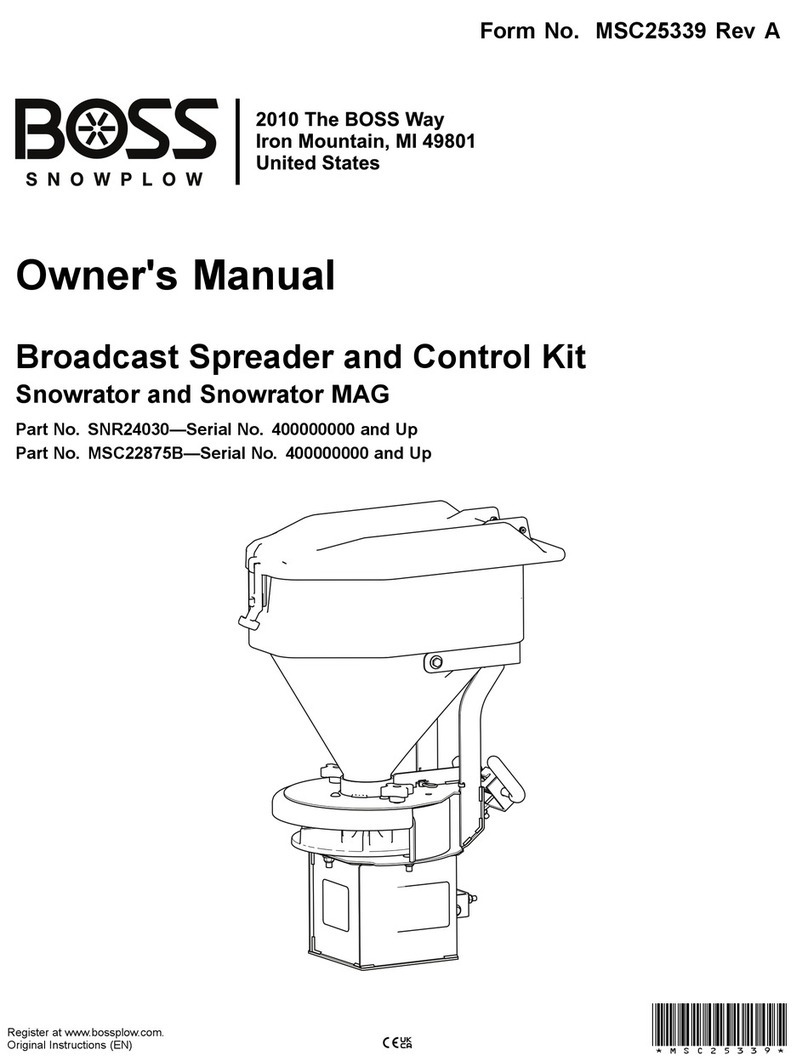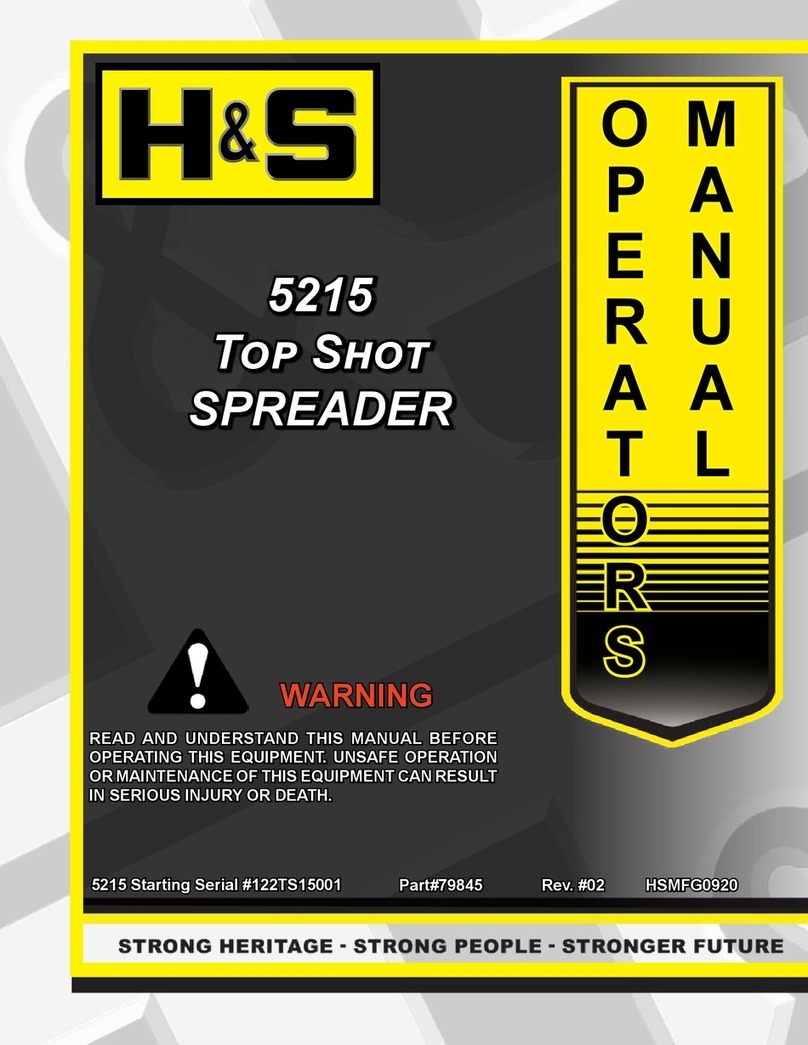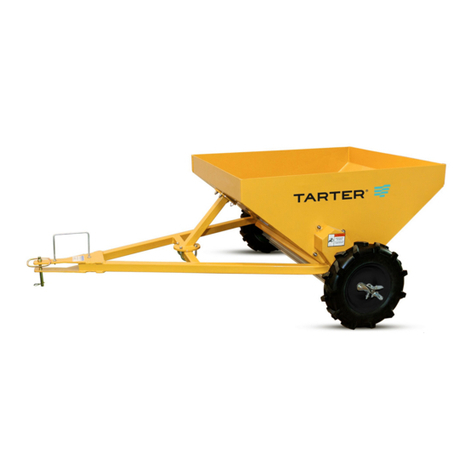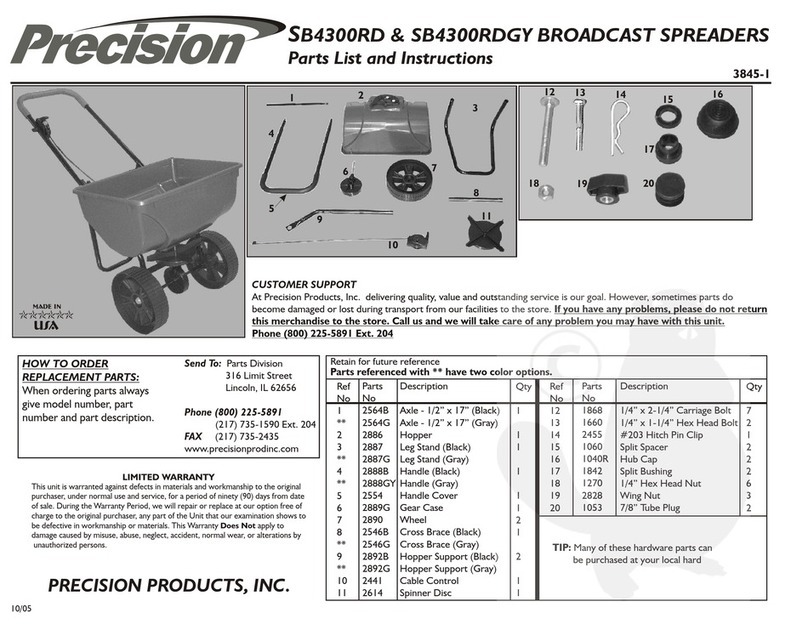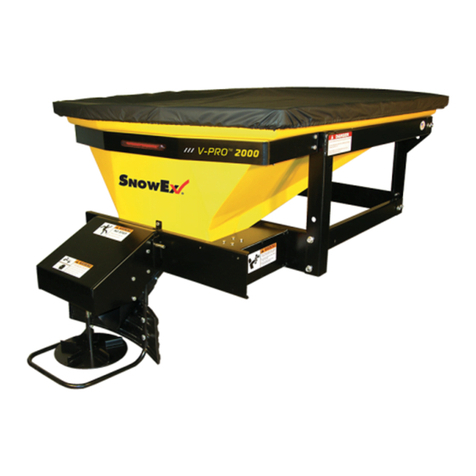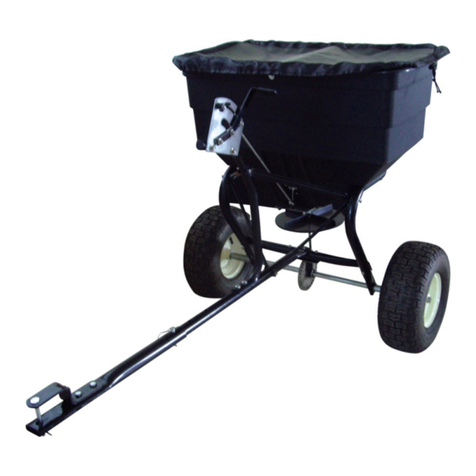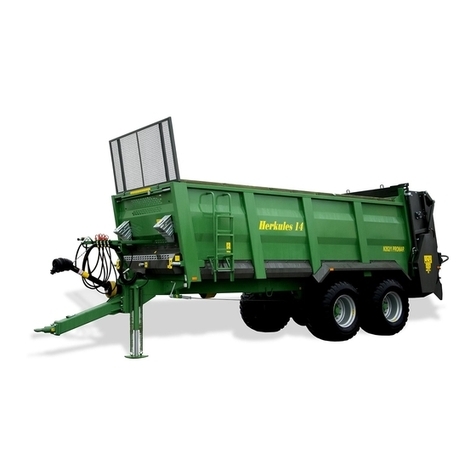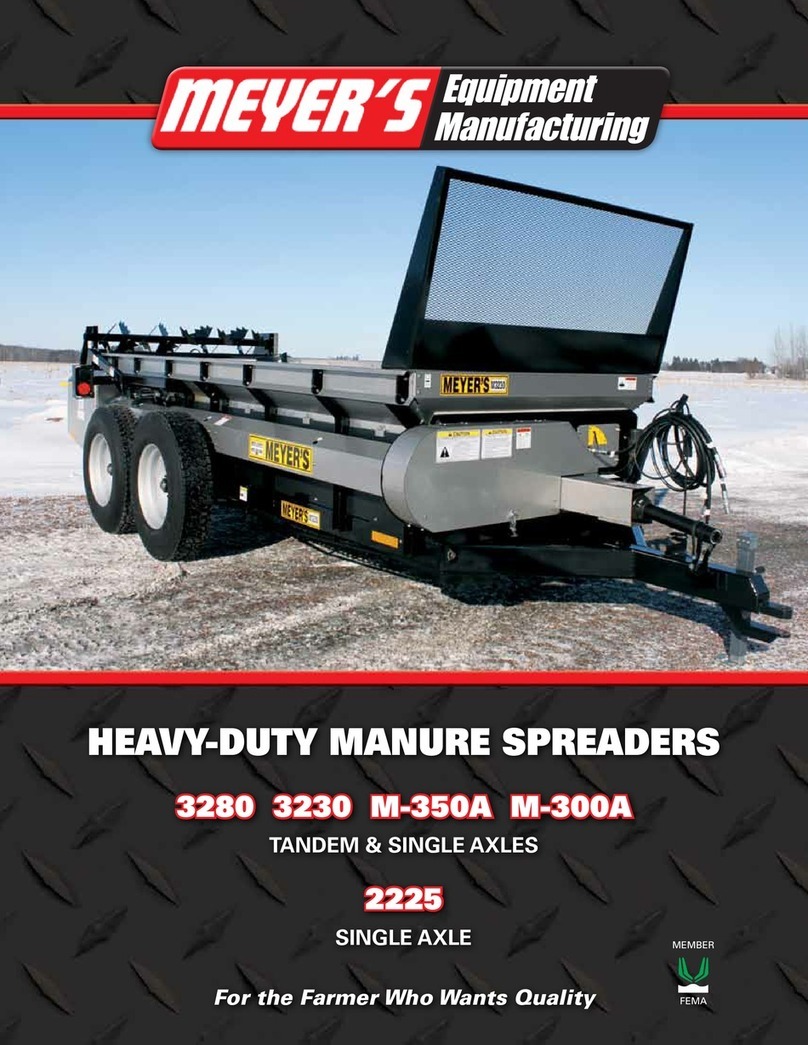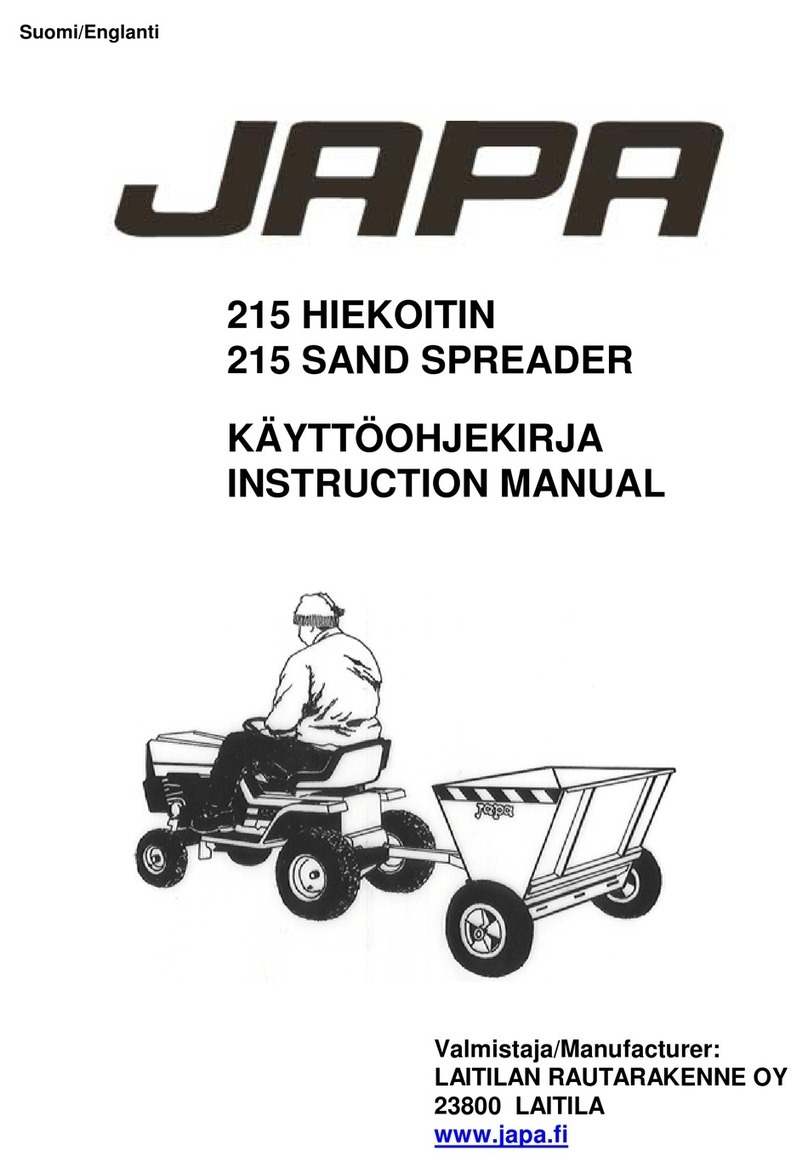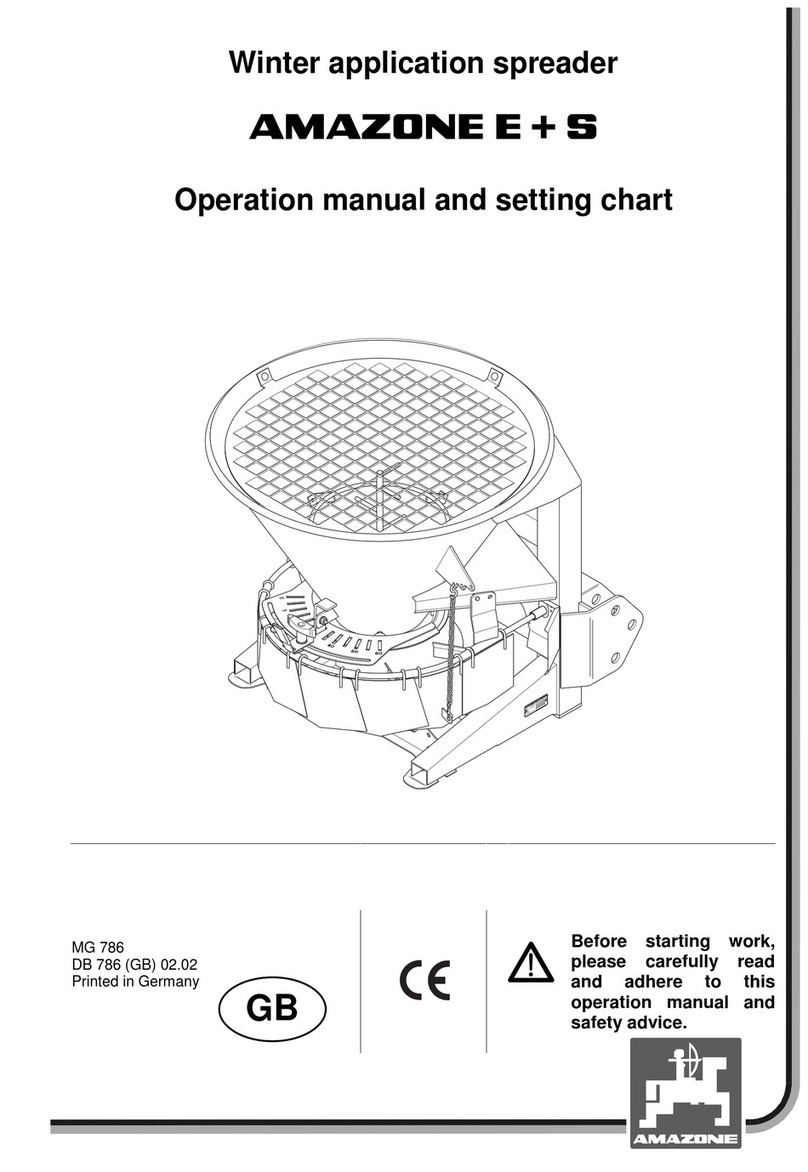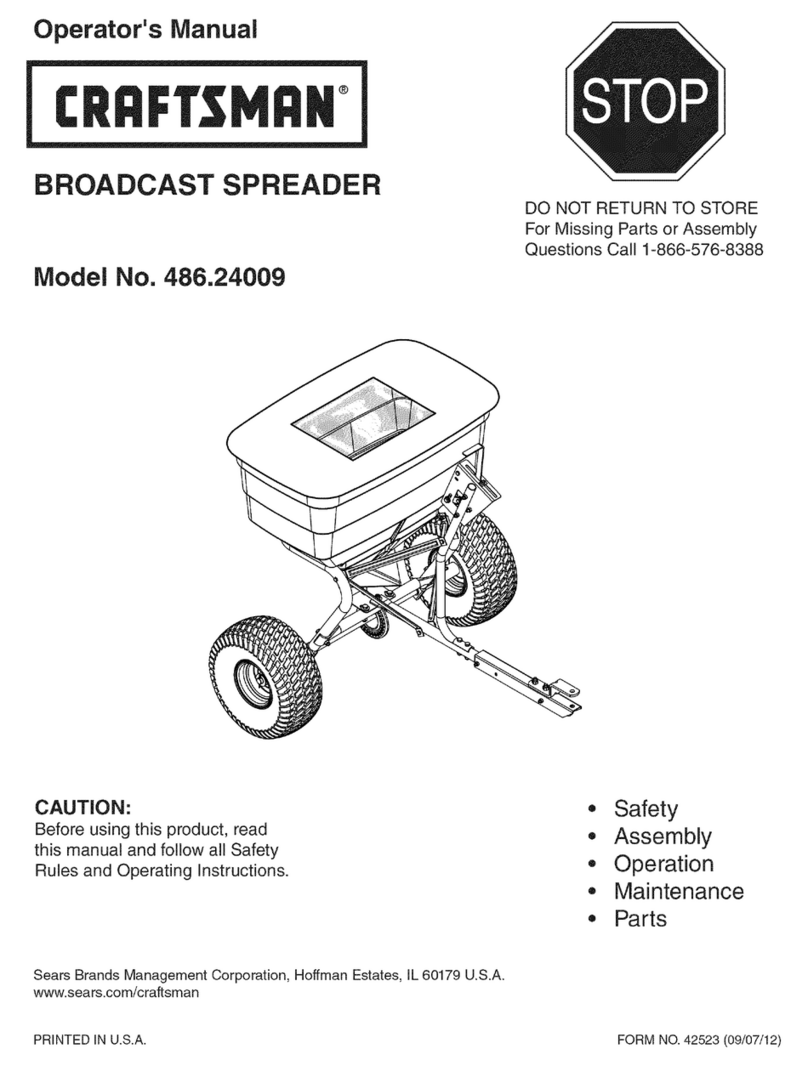Trynex International TurfEx TT5000 User manual

© TrynEx International 2016 85155 REV-A
Owner’s Manual
THIS MANUAL MUST BEREAD BEFORE OPERATING THE EQUIPMENT
TT5000
Serial No. 160201300750TT5000 and higher
CUSTOMER COPY
Madison Heights, Michigan 48071 866-5-TURFEX
www.turfexproducts.com

Table of Contents
© TrynEx International 2016 85155 REV-A
2
Introduction ....................................................................................................................................................................... 3
Safety .......................................................................................................................................................................... 4-12
Safety Labels ............................................................................................................................................................... 4
Warnings ................................................................................................................................................................. 5-12
Operating Instructions ............................................................................................................................................... 12-23
Driver Training ....................................................................................................................................................... 12-17
Machine Diagrams ................................................................................................................................................ 18-19
Dashboard Controls ................................................................................................................................................... 20
Machine Usage ..................................................................................................................................................... 21-22
Spray Boom ............................................................................................................................................................... 23
Calibration ................................................................................................................................................................. 24-42
Instructions ............................................................................................................................................................ 24-25
Reference Charts – Spread ....................................................................................................................................... 26
Suggested Nozzle Pairs ............................................................................................................................................. 27
Reference Charts – Broadcast .............................................................................................................................. 28-33
Reference Charts – Trim ....................................................................................................................................... 34-39
Reference Charts – Boom Nozzles ....................................................................................................................... 40-42
Maintenance .............................................................................................................................................................. 43-47
Troubleshooting ......................................................................................................................................................... 48-51
Specifications ................................................................................................................................................................. 52
Notes ......................................................................................................................................................................... 53-54
Have a question or need assistance?
TurfEx Customer Care 866-5-TURFEX
or (248) 586-3500
Monday through Friday 8:00 AM to 4:30 PM EST
Fax: (248) 691-8378
E-mail: [email protected]
Website: www.turfexproducts.com

Introduction
© TrynEx International 2016 85155 REV-A
3
This manual is intended to help you to get to know your TT5000 Ride On Spread N Spray and how to operate it safely,
correctly and economically. If you observe these instructions, you will prevent hazards, reduce repair costs and
breakdown times, and increase the reliability and service life of the machine.
The manual must be read and used by every person who will be working with or on the machine, including:
•
Operation (including preparation, repair during operation, & clean-up)
•
Repairs (maintenance, inspection, overhaul)
•
Transport
All regulations for safety and proper working practice must be observed in addition to this manual. Should you lose your Owner’s
Manual or would like extra copies, they can be obtained from your TurfEx dealer or retrieved from the TurfEx website
–
www.turfexproducts.com.
SAFETY ALERT DEFINITIONS
Indicates a hazardous situation that, if not avoided, will result in death or serious
injury. This signal word is to be limited to the most extreme situations.
Indicates a hazardous situation that, if not avoided, could result in death or serious
injury.
Indicates a hazardous situation that, if not avoided, could result in minor or
moderate injury.
Indicates information considered important, but not hazard-related (e.g. messages
relating to property damage).
IMPORTANT EQUIPMENT INFORMATION
Record important machine information here for quick reference. The TT5000 serial number is found on a label located
underneath the dashboard on the right-hand side. The engine serial number is located on the side of the engine, by the pull-start
coil.
Model
Serial #:
Engine Serial #:
Date Purchased:
Dealer where purchased:
Example serial number label:

Safety
Labels
© TrynEx International 2016 85155 REV-A
4

Safety
Warnings
© TrynEx International 2016 85155 REV-A
5
#WARNING/CONTENT
1ALWAYS HAVE SAFETY SWITCH LANYARD ATTACHED TO
OPERATOR WHEN MACHINE IS RUNNING.
2OWNER’S RESPONSIBILITY
The owner is responsible for training them self and all other operators and mechanics. Before starting the
engine and/or operating the machine, each operator must read and understand the Owner’s Manual.
Training must include supervised driver’s training with adequate time to practice for the operator to
become competent in operating the machine in all conditions. It is the owner’s responsibility to perform
the maintenance as described in the Maintenance Instructions. The owner and operator can prevent, and
are responsible for accidents or injuries occurring to themselves, other people, or property.
3SUPERVISED DRIVER’S TRAINING IS REQUIRED FOR ALL
OPERATORS AND MECHANICS
An untrained operator or mechanic can cause an accident, resulting in serious injury to himself or
bystanders.
•
All operators and mechanics must be trained. The owner is responsible for training the users.
•
Driver’s Training should be conducted under the direct supervision of an experienced operator.
•
The Driver’s Training section provides a step by step outline of what shall be covered during training.
•
The trainer shall supplement the training procedures provided in the Driver’s Training and Operation
sections with any additional instruction deemed necessary to ensure the safe operation of the
TT5000. The trainer should add additional instruction as necessary to provide the trainee with
additional useful information.
•
The trainer should supplement the presentation of material in the Driver’s Training and Operation
sections with instruction and references to all warning messages that appear in the Safety pages
and on the Safety Labels.
•
Before proceeding to more advanced training, the trainee must demonstrate the ability to satisfactorily
control the machine while starting, stopping, turning, getting on and off, or other tasks that have been
taught up to that point.
•
Initial training should take place on a flat open area free of obstructions with the TT5000 in 1st gear.
•
As the trainee progresses to more advanced phases of training the degree of difficulty may be
increased, but at each phase the initial training must begin on terrain that has a low degree of difficulty.
This is particularly important to keep in mind when learning how to operate on inclines and slopes.
•
The trainer shall demonstrate the principles covered in each phase.
4MINIMUM OPERATOR QUALIFICATIONS
AN OPERATOR OF THIS MACHINERY MUST MEET THE FOLLOWING QUALIFICATIONS:
•
The operator must be an experienced professional lawn care technician with a demonstrated ability to
apply fertilizer and pesticide products safely and correctly.
•
The operator must meet all state Pesticide Applicator Certification requirements.
•
The operator must be at least 18 years old.
•
The operator must be physically fit and able to lift 50 pounds with ease.
•
The operator must weigh between 120 and 300 pounds.
•
The operator must understand the information contained in this manual. Never let children or untrained
persons operate or service the equipment. Local regulations may restrict the age of the operator.

Safety
Warnings
© TrynEx International 2016 85155 REV-A
6
5OPERATOR CLOTHING AND PERSONAL PROTECTIVE EQUIPMENT
(PPE)
•
Always read and follow product labels and MSDS sheet requirements for Personal Protection Equipment
•
Wear substantial waterproof footwear and tightly secure all laces and straps.
•
Do not wear shorts. Instead, always wear close fitting clothing and jackets to prevent clothing from
getting caught on the handle bars or other control levers.
•
Wear appropriate clothing including a hard hat, safety glasses and hearing protection. Long hair,
loose clothing, straps, shoelaces or jewelry may get caught in moving parts.
6SAFETY DEVICES
Do not operate machine unless all safety devices are in place and in good working condition.
SAFETY DEVICES INCLUDE:
•
Machine Safety Labels.
•
Operator Presence Control/Throttle/Centrifugal Clutch. Letting go of the throttle lever disengages power
to the drive wheels.
•
Front Brakes with lock. The front brake has a spring to limit the force applied and reduce possibility of
lock-up. Locked brakes are parking brakes.
•
Safety switch lanyard is attached to operator.
•
Slip resistant footpad.
•
Belt guard securely fastened.
•
Neutral switch which prevents the TT5000 from starting in gear.
•
Fluid filled tires which provide ballast and lower the center of gravity.
7
OPERATION
•
Do not change the engine governor setting or overspeed the engine. The top engine speed when the
machine is in neutral is 3450 RPM. Use the electronic multifunction display to monitor the top speed and
make adjustments as necessary.
•
Always stop the machine before shifting gears. Never shift gears while the machine is moving as this
may cause a rapid slowdown or stop the front wheels causing loss-of-control or a tip over.
•
Only operate in good visibility conditions. Avoid holes and inspect work area for hidden hazards before
starting machine engine.
•
Be sure the machine is in neutral and all brakes are locked before starting.
•
Use caution stepping on or off the sulky to avoid tripping. Never use machine without sulky or operate on
wet grass.
•
Use extra care when operating this machinery on inclines or slopes. Be sure to refer to the Operator’s
Manual for specific instructions regarding operating the machinery on slopes and/or inclines. Turf
conditions can affect the machine’s stability. Use caution while operating near drop-offs or other hazards.
•
Never operate with the guards not securely in place. Be sure all interlocks are attached, adjusted
properly, and functioning before starting the engine.
•
Stop on level ground, lock all brakes, shut off engine and shift into neutral before leaving the operators
position for any reason.
•
Keep hands, feet, clothing and loose objects away from moving parts and pinch points.
•
Never carry passengers.
•
Keep a safe distance between the machine and all third parties.
•
Slow down and use caution when making turns and/or crossing roads and sidewalks.
•
Use care when loading or unloading the machine into a trailer or truck.
•
Avoid distractions, including but not limited to cell phones and mp3 players while operating this machine.
Operators must concentrate and focus on the safe use of this machinery at all times.
•
Maintain a firm hold on the handlebars.
•
Do not touch the hot muffler while running or after shutdown.
•
Wear eye protection and necessary Personal Protection Equipment (refer to chemical label) when using
compressed air or water to clean the machine.
•
Do not operate the machine under the influence of alcohol or drugs.

Safety
Warnings
© TrynEx International 2016 85155 REV-A
7
8INSPECTING WORK AREA
PRIOR TO OPERATING, CAREFULLY INSPECT THE WORK AREAS FOR HAZARDS OR UNEVEN
GROUND THAT MAY BE HIDDEN IN THE GRASS.
•
Clear the work area of moveable objects such as branches, wires, rocks, glass etc. that may interfere
with the machine.
•
Mark the location of all immovable objects or irregular areas.
•
Avoid hitting obstacles such as holes, abrupt changes in ground contour, branches, stumps, roots,
protruding pipes, paving edges, etc. that could unexpectedly turn, stop, or upset the machine possibly
throwing you off, into or over the handle bars causing serious injury or death. The faster you are
moving, the more potential there is for injury.
•
Keep away from drop-offs, the edges of ponds, streams, pools, etc., especially at the bottom of slopes.
EVALUATE THE TERRAIN.
•
Determine what accessories and attachments are needed to properly and safely perform the job. Only
use accessories and attachments approved by the manufacturer.
•
Study the terrain and plan a safe operating pattern. If no safe operating pattern exists do not attempt to
drive the TT5000 in that area.
If hills are present, refer to additional Warnings in “Hillside Operation” in this section.
EVALUATE THE TURF CONDITIONS.
•
Do not operate if conditions are wet
•
Do not operate in dim/low light.
9FUEL SAFETY
Use extra care when handling gasoline and other fuels. They are flammable and vapors are explosive.
•
Always shut off fuel valve when transporting or storing the machine.
•
Never remove gas cap or add fuel when engine is running or hot. Allow it to cool first.
•
Do not smoke and stay clear of any sparks or open flames.
•
Never refuel or drain the machine indoors. Move machine outdoors instead.
•
Clean up fuel spills immediately. Do not attempt to start the machine near a fuel spill. If fuel is spilled on
clothing, do not attempt to start the machine, stay away from open flames, sparks or other sources of
ignition, and change clothing.
Do not run engine in an enclosed area or indoors. The engine gives off carbon monoxide, a poisonous gas.
PREVENT FIRES.
•
Keep engine clean and free from debris.
•
Clean up spilled fuel.
•
Check and repair leaking fuel lines, fittings and cap.
•
Do not park near an open flame or other source of ignition, such as a furnace or water heater.
10 INSPECT MACHINE BEFORE EACH USE
EXAMINE THE MACHINE PRIOR TO EACH USE. DO NOT USE THE MACHINE IF ANY PARTS ARE
NOT IN GOOD WORKING CONDITION.
•
Check for worn tires, cracks in parts, loose or missing bolts, cotter pins, etc. and replace or repair before
operating.
•
Make sure all safety devices are present and in good working order, including all the safety labels,
shields, brakes, the neutral safety switch, and throttle/clutch. (To test the brakes, neutral safety switch,
and throttle/clutch, follow instructions found in the Driver’s Training and Operating Instructions sections
of this manual.)
•
Make any necessary repairs or adjustments before starting the engine and/or operating the machine.
11 ENGINE STARTING SAFETY
DO NOT ATTEMPT TO START THE MACHINE IF ANY OF THE FOLLOWING APPLY:
•
You are in a confined space.
•
You or someone else could be trapped between the machine and a solid obstacle should the machine

Safety
Warnings
© TrynEx International 2016 85155 REV-A
8
unexpectedly move upon startup. Remember to check for low hanging obstacles such as tree branches,
clotheslines, etc.
•
You are not certain of firm, dry, level footing to prevent loss of balance
BEFORE ATTEMPTING TO START ENGINE:
•
You must move the machine to a solid, level, dry, open area.
•
Verify the machine is in neutral. The machine rolls forward easily in neutral.
•
Lock front brake and apply the sulky brake.
•
Do not operate the throttle.
DO NOT ATTEMPT TO START OR OPERATE THE MACHINE IF:
•
The neutral safety switch system or any other safety device is not working.
•
The throttle/clutch does not move freely or automatically and rapidly return to the idle position.
•
The idle engine speed exceeds 1650 RPM upon starting.
•
The machine unexpectedly moves upon starting or when shifting gears.
12 AVOIDING SLIPPING OR TRIPPING INJURY
Use caution when riding on, and getting on and off the TT5000.
•
Keep a firm grip on the handles with both hands.
•
Stand only on the footpads. .
•
Keep footpads clean.
•
Replace worn or damaged footpads.
13 FORWARD OPERATION
Loss-of-control may cause death or serious injury.
•
Always keep a firm grip on the handlebars with both hands.
•
Operate the machine in 1st gear until you become familiar with it.
•
Never operate the machine at a greater speed than is reasonable in light of the conditions presented.
•
Only operate in 1st Gear on slopes, inclines, bumpy ground, or high grass.
•
Avoid sudden starts, stops and turns as they may cause you to lose your balance and/or be thrown from
the machine.
14 REVERSE OPERATION
Loss-of-control may cause death or serious injury.
•
Always keep a firm grip on the handlebars with both hands.
•
Do not back up if there is a possibility you or a bystander could become trapped between the machine
and an immovable object or barrier.
•
Always look behind and down before backing up to be sure of a clear path.
•
Always look behind and up before backing up to be sure the path is clear of low hanging obstacles such
as tree branches, clotheslines, or low door- ways.
•
Use extra caution backing up when in an enclosed area.
•
Backup slowly, until you become familiar with how the machine handles.
•
Never coast backwards. Instead, back up under power and in reverse with the throttle engaged using the
brakes as necessary.
•
Use extra caution backing from an awkward location or position.
•
Keep both feet firmly on the footpads whenever possible.
•
Backing up while in the walking position is hazardous and in most cases can and should be avoided.
However, when backing up from the walking position is unavoidable (such as when unloading the
machine from a trailer), use extreme caution.
15
TO AVOID LOSS-OF-CONTROL, TIP-OVER, AND ROLLOVER:
Loss-of-control, tip-over or rollover may cause death or serious injury. This machine has a high center
of gravity and turf conditions affect stability. Slopes are a major factor in loss-of-control, tip-over, and
rollover accidents.
•
Never shift gears while the machine is moving as this may cause a rapid slowdown or stop the front

Safety
Warnings
© TrynEx International 2016 85155 REV-A
9
wheels, causing loss-of -control or a forward tip over. Instead, bring the machine to a complete stop
before shifting gears.
•
Study the terrain before beginning work and plan a safe operating pattern. If the area at issue will
not accommodate a safe operating pattern, do not attempt to drive the TT5000 in that area.
•
Do not operate on slopes or inclines where traction and stability are doubtful.
•
Do not ride on slopes exceeding 15 degrees.
•
Never operate on wet slopes.
•
Look for holes, ruts, rocks, and other hidden hazards in the work area before starting work. Uneven
terrain can overturn the machine. Tall grass can hide hazards.
•
Do not operate near drop-offs, ditches, or bodies of water.
•
Keep a firm grip of the handlebars with both hands at all times.
•
Slow down and lean into turns for better balance and to transfer your weight to the inside wheels to
prevent loss-of-control, tip over, or rollover.
•
Tires with excessively worn tire tread are dangerous on slopes or inclines. Replace tire(s) with less
than 1/4” of tread remaining. Only use liquid filled tires supplied by TurfEx. Maintain tire pressure at 12
PSI. Higher pressures will cause the tires to lose traction and under inflated tires will cause instability.
•
Do not attempt to climb over curbs or parking blocks while operating the TT5000 at high speed as this
may cause a forward tip-over.
TO HELP AVOID LOSS-OF-CONTROL, TIP OVER, AND ROLLOVER, USE EXTREME CAUTION ON
INCLINES, AND SLOPES:
•
Use 1st gear to provide improved traction and a slower ground speed.
•
Travel across the grade. Begin at the bottom of the slope and work your way up.
•
Avoid traveling straight down a slope. When descending a slope, zigzag or slalom across the grade
gradually downwards using the brakes to slow the machine.
•
Lean uphill at all times to provide better balance and to transfer weight to the uphill tires.
•
Slow down and avoid sharp turns and sudden starts and stops.
•
Reduce the amount of granular and/or liquid products carried.
•
Apply rear brakes first and then front brakes.
Operate the TT5000 as a walk-behind unit in situations where loss -of-control, tip-over, or rollover is
possible.
When traveling up a slope, be aware that the drive tires have reduced traction and there is greater risk
that the machine could tip backwards.
RECOMMENDATIONS FOR DRIVING UP AN INCLINE OR SLOPE:
•
Lean forwards to provide better balance and to transfer more weight to the front drive wheels.
•
Accelerate gently. Accelerate slowly. Accelerating too quickly may result in a loss of traction.
•
Do not make sharp or quick turns. Making sharp or quick turns may cause you to lose your balance and
be thrown off the machine or cause a side rollover.
•
In areas of poor traction, operate the machine as a walk behind unit.
•
If you experience a loss of control while driving the machine on an upward slope, step backwards off the
operator’s platform and apply the brakes. Once the brakes are applied, take corrective action.
•
Backing down a slope is a hazardous maneuver which should be avoided. To avoid backing down a
slope; stop the machine, apply the brakes, step off the Driver’s platform, steer the front of the machine
across the grade, and gradually engage the Throttle/Clutch. If backing down a slope is unavoidable
(such as when unloading the machine from a trailer), use extreme caution. Read Warning, “Reverse
Operation” for details on backing up.
When pointing downhill, the weight and traction is transferred to the front drive wheels. Avoid driving the
machine at this angle as the machine may tip over.
RECOMMENDATIONS FOR DRIVING DOWNHILL:
•
Lean backwards as you travel downhill to provide better balance for you and transfer more weight to the
rear wheels. If necessary, extend your arms and squat down backwards with arms extended to transfer
more weight further to the rear.
•
Do not change speed suddenly. Do not accelerate. Decelerate gently by applying the rear brakes first,
followed by the front brakes.
•
Use extreme caution when turning. Do not make sharp turns as you may lose your balance and/or be
thrown from the machine or lose control. When making turns, slow down and make gradual turns.
•
Zigzag or slalom slowly and gradually downhill traveling across the grade using both brakes to slow your
speed. The steeper the slope the more gradual the slaloms should be between the switchbacks.
•
Avoid any obstacles that could suddenly stop the front wheels causing a tip over.
•
If you ever lose control while driving down a slope, let go of the handles and jump off to the rear, if
necessary.

Safety
Warnings
© TrynEx International 2016 85155 REV-A
10
•
Backing uphill is a risky maneuver which should be avoided. To avoid backing uphill; stop the machine,
apply the brakes, step off the Driver’s platform, steer the front of the machine across the grade, and
gradually engage the Throttle. When backing uphill is unavoidable, use caution.
When pointing across an incline, slope or hill sideways, the weight distribution between the front drive
wheels and the rear wheels is similar to level ground. However, more weight is transferred to the lower
wheels which may cause the machine to rollover towards the downhill side. This is the preferred angle for
driving on gentle slopes.
RECOMMENDATIONS FOR DRIVING ACROSS A HILLSIDE:
•
Lean uphill to provide better balance for you and transfer more weight to the uphill wheels.
•
Do not change speed suddenly.
•
Do not make sharp turns as you may lose your balance and be thrown off the machine or lose control.
When making turns, slow down and make gradual turns. The machine also has a tendency to rollover
when performing this maneuver.
•
Avoid making downhill turns as it will be more difficult for to maintain balance and control over the
machine.
•
Avoid any obstacles that could suddenly pitch the front uphill wheel upwards causing a rollover towards
the downhill side.
•
If you ever lose control while driving across a slope let go of the handles and jump off to the uphill side of
the machine, if necessary.
Backing up across the grade is a maneuver which in should be avoided. To avoid backing up; stop the
machine, apply the brakes, step off the driver’s plat- form, steer the front of the machine in the desired
direction, and gradually engage the throttle. When backing up is unavoidable, use caution. Read
Warning 14 “Reverse Operation”, for details on backing up.
16 TRANSPORTING
Driving up and down ramps is hazardous. The risks include tip-over, rollover, loss-of-control, and back-
over.
Use extreme caution when driving the TT5000 onto and off of a transport, (such as a vehicle, carrying
rack, or trailer).
•
When loading and unloading, park the transport on level pavement well away from puddles,
obstacles, and curbs that may cause the operator to lose his footing or become entrapped. Allow
adequate room for the ramps to be deployed and the machine and operator to come straight on or off
the transport platform and ramps.
•
To prevent a ramp from slipping out from under the machine, make sure the ramp is securely
fastened to the transport platform and that the ramp and machine wheels are properly aligned with
each other.
•
Never unload a TT5000 by shifting it into neutral and allowing it to freewheel backwards down a
ramp. Rather, the driver must start the TT5000 while on the transport platform, shift the engine into
reverse, and inch the machine down the ramp under power using the brakes as necessary. Read
Warning “Reverse Operation”, for required precautions while operating the TT5000 in reverse.
•
If there is not adequate standing room for the operator on the transport platform, the machine should
be started while the operator is standing on the ground.
•
If an enclosed transport is used, use extra caution starting and operating the TT5000 inside the
enclosure.
Transporting the machine over the road can be hazardous. The risks include but not limited to traffic
accidents, failure of transport system, and ejection of the machine from the transport.
Transporting the TT5000 requires a heavy duty transport capable of safely carrying a fully loaded
TT5000 weighing 700 lbs. plus the weight of all materials carried on the transport.
•
Follow transport manufacturer’s precautions and always use all safety devices provided.
•
DO NOT overload or unbalance the transport or hitch.
•
Use only heavy duty ramps with a minimum width of 8.5 inches and an anti-slip surface. The ramps
must be capable of supporting 1000 lbs. or the combined weight of the machine and driver,
whichever is greater. The ramp angle must be 15 degrees or less.
•
To prevent the machine from being thrown from the transport, always secure the machine to the
transport’s platform. Use securing devices provided by the manufacturer. Each securing device must
have a minimum load rating of 1,400 lbs. and elastic straps or similar devices may not be used.

Safety
Warnings
© TrynEx International 2016 85155 REV-A
11
•
Check transport, ramps, hitch, and securing devices each time they are used.
•
Check carefully for cracked welds or parts, loose or missing hardware, excessive wear or damage, or
missing/nonworking safety and securing devices.
•
If a carrying rack is used, check for damage caused by the rear edge dragging or bottoming out on the
pavement. This can result in structural failure of the rack, hitch and vehicle frame or hardware.
•
Do not use the transport if it is not in good working condition. Make necessary repairs or replacements
before using.
17 CHECK WHEEL FASTENERS
If wheel fasteners are not tight, a serious accident may occur.
•
Check wheel fastener tightness frequently during the first 10 hours of operation.
•
After loosening any wheel fasteners, frequently check their tightness for the next 10 hours of operation.
18 PARKING
ANY TIME YOU LEAVE THE OPERATOR POSITION, YOU MUST:
•
Stop on level ground
•
Turn off the engine.
•
Lock brake lever.
•
Shift into neutral
Never leave the machine unattended on an incline where someone could disengage the brakes and the
machine could roll.
•
When leaving the machine unattended, close fuel shut off valve.
19
TIRE SAFETY
Tires are filled with pressurized windshield washer solution to provide ballast for a lower center of
gravity. Explosive separation of rim and tires may cause serious injury.
•
DO NOT remove fluid from tires.
•
All replacement tires must be fluid filled.
•
Wear a face shield when checking, filling, and repairing fluid filled tires.
•
Do not attempt to check, repair or replace fluid fill tires without the proper equipment.
•
Use a clip-on chuck and extension hose. Stand to the side of the tire when filling.
•
Always maintain tire pressure at 12 PSI. Do not under or over inflate tires.
•
Rear tires have split rims. Release tire pressure prior to loosening any nuts or bolts.
•
Never weld or heat the tire/rims as this could cause a tire explosion or structural damage to the rim.
•
Check tires often for cuts, wear, bubbles and missing or loose lug nuts. Check pressure often.
•
Fix or replace worn or damaged tires, rims, and hardware.
•
Always replace tires with genuine TurfEx liquid-filled tires and rims.
20 MAINTENANCE AND SERVICE
Improper maintenance can cause serious injury.
•
Lock brakes, stop engine and disconnect spark plug wire. Wait for all movement to stop before
adjusting, cleaning or repairing.
•
Clean grass and debris from drives, mufflers, and engine to help prevent fires. Clean up oil or fuel
spillage.
•
Let engine cool before storing and do not store near flame.
•
Shut off fuel while storing or transporting. Do not store fuel near flames or drain indoors.
•
Park machine on level ground. Never allow untrained personnel to service machine.
•
Use jack stands to support components when required.
•
Carefully release pressure from tires and spray system.
•
Remove spark plug wire before making any repairs.
•
Keep hands and feet away from moving parts. If possible, do not make adjustments with the engine
running.
•
Keep all parts in good working condition and all hardware tightened.

Safety
Warnings
© TrynEx International 2016 85155 REV-A
12
•
Replace all worn or damaged machine safety labels.
•
Replace worn or damaged footpads.
•
Perform all scheduled maintenance as directed in the service manual
21 PESTICIDE SAFETY
The improper use, handling, application, and disposal of pesticide products applied by this machine may
cause death or serious injury.
•
Read and follow product label and Material Safety Data Sheet (MSDS) precautions for handling,
mixing, applying, and disposing of pesticides. Some materials may present health hazards that will
require the use of Personal Protective Equipment (PPE). Always wear required PPE.
•
Keep required PPE available for use by the operator or mechanic at all times.
•
Keep pesticide labels and MSDS available for the operator or mechanic at all times.
22 HANDLING AND DISPOSAL OF HAZARDOUS WASTE PRODUCTS
Dispose of all hazardous waste products properly.
•
Clean up spills immediately.
•
Refer to the pesticide label for proper handling and disposal instructions.
•
Refer to MSDS for proper handling and disposal instructions.
•
Wear the Personal Protective Equipment specified on MSDS and pesticide labels.
•
Before disposing of hazardous waste check with your local regulatory agency
•
.

Operator Instructions Driver Training
© TrynEx International 2016 85155 REV-A
13
ADDING GASOLINE
Read Warning 9: “Fuel Safety”
•
Move the machine outdoors.
•
Emphasize fuel handling safety.
•
Add gasoline/fill tank.
INSPECT MACHINE BEFORE EACH USE
Read Warning 10: “Inspect Machine Before Each Use”
EXAMINE THE MACHINE PRIOR TO EACH USE. DO NOT USE THE MACHINE IF ANY PARTS ARE NOT IN GOOD
WORKING CONDITION.
•
Check for worn tires, cracks in parts, loose or missing bolts, cotter pins, etc. and replace or repair before operating.
•
Make sure all safety devices are present and in good working order, including all the safety labels, shields, brakes, the neutral
safety switch, and throttle/clutch. (To test the brakes, neutral safety switch, and throttle/clutch, follow instructions found in the
Driver’s Training and Operating Instructions sections of this manual.)
•
Make any necessary repairs or adjustments before starting the engine and/or operating the machine.
•
Check the spray nozzle alignment and pattern; adjust as necessary.
•
Check the spreader control settings; adjust as necessary.
Read Warnings: “Inspect Machine Before Each Use”, “Check Wheel Fasteners”, and “Tire Safety” before starting or operating the
machine.
STARTING, STOPPING, AND PARKING THE MACHINE.
Read Warning 11: “Engine Starting Safety”
Read Warning 18: “Parking”
TO START ENGINE:
•
Locate machine on a flat, level area free from obstacles and bystanders.
•
Shift into neutral.
•
Lock brake lever.
•
Make sure safety switch lanyard is attached.
•
Choke engine if necessary.
•
DO NOT pull throttle lever while starting.
•
Turn the key.
TO STOP ENGINE:
•
Lock front brake lever
•
Shift into neutral
•
Push kill switch.
TO PARK MACHINE:
•
Stop on level ground.
•
Lock brake lever
•
Shift into neutral
•
Push kill switch.
•
When leaving the machine unattended, close fuel valve.
PROPER SHIFTING TECHNIQUES.
IMPORTANT: Excessive force applied to the shift lever can cause internal transaxle damage and other damage which is not covered
by Warranty. WARNING: Never shift gears while the machine is moving as this may cause a tip-over or loss-of control.
TO CHANGE GEARS:
•
Release throttle.
•
Bring the machine to a complete stop.
•
Shift into the desired gear. If the machine does not shift easily, move the front of the machine angling it right or left until the
transaxle gears shift easily.
IMPORTANT: Emphasize the necessity of not forcing the shift lever.
SAFELY STEPPING ON AND OFF THE SULKY.
Read Warning 12: “Avoiding Slipping or Tripping Injury”

Operator Instructions Driver Training
© TrynEx International 2016 85155 REV-A
14
DEMONSTRATE AND INSTRUCT THE TRAINEE IN THE FOLLOWING PHASES.
Read Warning 5: “Operator Clothing and Personal Protective Equipment”
Read Warning 7: “Operation”
Read Warning 8: “Inspecting Work Area”
Read Warning 13: “Forward Operation”
PHASE I: DRIVING THE MACHINE IN 1ST GEAR
Initial training should take place outdoors in a flat open area free of obstructions with the machine in 1st gear and the hopper and
tank empty. Initial training should include the following:
TO DRIVE FORWARD:
•
Safely start the machine.
•
Safely step onto the operator platform.
•
Shift into 1st gear.
•
Unlock brake
•
Pull the throttle.
TO STOP:
•
Release the throttle.
•
Step on sulky brake pedal then pull the front brake lever.
TO TURN RIGHT:
•
Pull back on the right handle while simultaneously pushing forward on the left handle.
•
Always lean into the turns by shifting your body weight to the inside of the turn.
TO TURN LEFT:
•
Pull back on the left handle while simultaneously pushing forward on the right handle.
•
Always lean into the turns by shifting your body weight to the inside of the turn.
PHASE II: DRIVING THE MACHINE IN 2ND GEAR.
Repeat Phase I training using 2nd gear.
PHASE III: DRIVING WITH A LOAD.
•
Repeat 1st and 2nd gear training outlined in Phase I and Phase II with a partially filled hopper and tank.
•
Gradually increase the weight as the trainee demonstrates his or her ability to control the machine with the increased weight.
PHASE IV: OPERATING THE MACHINE AS A WALK-BEHIND UNIT.
Read Warning 12: “Avoiding Slipping or Tripping Injury”
Stop, shift into 1st gear or reverse, and keeping a firm grip on both handles and while operating the machine as a walk behind unit,
perform the training procedures outlined in Phases I through IV.
Note that walk-behind use is not recommended unless absolutely necessary.
PHASE V: DRIVING THE MACHINE ON HILLSIDES.
Read Warning 15: “To Avoid Loss-of-Control, Tip-Over, and Rollover”
Initial hillside training should take place on a slightly hilly open area free from obstructions with the machine in 1st gear and the
hopper and tank empty.
•
The trainee must be familiar with the Driving Techniques before operating on slopes.
•
The trainee must pass the Phases I, II and IV and be totally familiar with all the WARNINGS and the hillside driving techniques
and principles set forth in the Driver’s Training and Operating Manual before operating the machine on a slope or incline.
Trainee must never ride the TT5000 on any slopes or inclines greater than 15 degrees.
•
As the trainee is able to demonstrate his ability to control the machine on hills as well as his understanding of hillside driving
principles and proper techniques; gradually increase the slope.
•
As the Trainee progresses, gradually add weight to the hopper and tank.
PHASE VI: DRIVING OVER CURBS.
Never attempt to drive over a curb at high speed as this may cause a forward tip-over.
•
Approach the curb or parking block straight on;
•
Stop the machine 12 inches away from the curb;
•
Shift into 1st gear
•
Gradually accelerate up and over curb.

Operator Instructions Driver Training
© TrynEx International 2016 85155 REV-A
15
If machine is unable to climb over a curb:
•
Look for a lower section of curb;
•
If one is not available, approach the curb on an angle and attempt to climb over one wheel at a time;
•
Use ramps to get over the curb where required. IMPORTANT: Avoid high curbs and bottoming out as this can cause machine
damage that will not be covered by the Warranty.
PHASE VII: BACKING UP.
Read Warning 14: “Reverse Operation”
TO BACK UP:
•
Stop, shift into reverse, look behind to make sure the path is clear, and keeping both feet on the operator s platform and a firm 2
handed grip on the handles gradually pull the throttle.
TO TURN RIGHT:
•
Pull back on the right handle while simultaneously pushing forward on the left handle.
TO TURN LEFT:
•
Pull back on the left handle while simultaneously pushing forward on the right handle.
TO STOP BACKING UP:
•
Release throttle and apply one or both brake levers to stop.
PHASE VIII: COMPLETING DAILY SERVICE CHECKLIST.
Read Warning 20: “Maintenance and Service”
Adjust and repair any irregularities discovered and report them to your supervisor.
•
Clean machine in a designated area. IMPORTANT: DO NOT power wash machine. High pressure water will force corrosive
fertilizer residue into bearings, linkages, and other parts. Corrosion damage is not covered by the Warranty. Instead use low
pressure air regulated to 30 PSI once a week or as necessary use low pressure water regulated to 30 PSI to wash machine. Start
and run machine after wash and blow dry to remove any water.
•
Empty hopper. NOTE: Use a dedicated pail or wet/dry vacuum to remove fertilizer so that it can be recycled.
CLEAN:
•
Spinner plate.
•
Footpads.
•
Nozzles and nozzle strainers, if necessary.
•
Spreader gate, auxiliary gate slide plate and linkage.
•
Engine cooling fins, blower housing inlet, starter, carburetor, governor linkage, throttle lever, and cable.
LUBRICATE AND PROTECT THE FOLLOWING, USING LIGHT OIL OR EQUIVALENT:
•
Operating controls and cables.
•
Spreader gate and auxiliary gate plate.
•
Carburetor and all linkages and springs. CHECK AND RECORD:
•
Engine idle speed (Must not exceed 1650 RPM).
•
Engine top speed (Must not exceed 3,450 RPM).
GAUGE, RECORD, AND ADJUST HOPPER CONTROL SETTINGS AS NECES- SARY, INCLUDING:
•
Auxiliary gate adjustment plate.
•
Spreader gate opening.
•
Rate adjustment knob
OTHER CHECKS AND ADJUSTMENTS:
•
Check and adjust the spray nozzle alignment as necessary.
•
Check and top off engine oil.
•
Check and top off clutch oil.
•
Check for loose or missing fasteners or parts, cracks in metal or welds.
PHASE IX: LOADING AND UNLOADING THE MACHINE ON A TRANSPORT.
Read Warning 16: “Transporting”
Trainee must be instructed how to safely load and unload the TT5000 from a transporting vehicle.
PHASE X: ADDITIONAL SERVICE TRAINING
Trainee should be instructed on any additional service he will be required to perform on the TT5000 such as, changing engine and
clutch oil, greasing, etc. Refer to service manual for scheduled service requirements and details.

Operator Instructions Driver Training
© TrynEx International 2016 85155 REV-A
16
PHASE XI: TESTING SAFETY DEVICES.
Read Warning 20: “Maintenance and Service”
Read Warning 6: “Safety Devices”
If any safety device fails a test, adjust, repair or replace the component before operating the machine.
1.
THROTTLE CONTROL
Components: throttle lever, throttle cable, multifunction display (tachometer), drive belt, idler pulley, idler tension spring, transaxle,
engine and components: carburetor and linkage, governor spring, throttle spring, throttle return spring, and clutch. All components
must be in place and functioning normally.
•
Park on level ground free from obstructions and bystanders. Lock front brake lever.
•
Pull and release throttle lever several times. Ensure that the lever moves smoothly and easily and snaps back when released.
•
Start engine and verify that the engine speed increases and decreases rapidly.
•
Engine idle. Ensure the engine idles smoothly without dying and the idle speed on the multifunction display does not exceed
1650 RPM.
•
Engine top end speed. Pull and hold throttle lever. Confirm that the top end speed does not exceed 3450 RPM.
•
Clutch engagement. Shift into 1st gear and gradually accelerate engine. Confirm that the machine does not move when shifted,
or creep at idle speed. The clutch shall engage smoothly as the engine is accelerated and propel the machine forward at 3.5
MPH at full acceleration. No unusual noise should be detected.
2.
NEUTRAL SAFETY SWITCH SYSTEM (NSSS)
Components: NSSS module, kill switch, neutral switch, kill wire, ground wire, wire harness and terminals.
•
Park on level ground free from obstructions and bystanders.
•
Lock front brake lever, shift into neutral and start engine.
•
Turn engine off with kill switch. Confirm that the engine starts and kill switch works.
•
Shift into 1st gear and repeat the previous test. Confirm that the engine does not start in gear.
3.
BRAKE SYSTEMS
Front Brake System:
Components: brake lever with lock, front brake cable, brake drum, band tension spring, sheath brake pin, rod brake pin.
•
Park a fully loaded machine on level ground free from obstructions and bystanders. Start engine.
•
While in NEUTRAL, push the machine forward. No unusual drag should be felt.
•
Pull and release the front brake lever several times. Ensure that the lever operates smoothly and snaps back completely when
released. The operating force on the lever must not exceed pounds.
•
Shift into 2nd gear, accelerate to full speed and pull the front brake lever. Confirm that the machine stops smoothly in less than 8
feet and the brake does not lock up.
Rear Brake System:
•
Push and release the sulky brake pedal several times. Confirm that the pedal operates smoothly and snaps back completely
when released. The operating force on the lever must not exceed 25 pounds.
•
While in NEUTRAL, push the machine forward. No unusual drag should be felt. Shift into 2nd Gear, accelerate to full speed, and
push Sulky Brake Pedal. Confirm that the machine stops smoothly in less than 8 feet. Confirm that both brakes create equal
drag without causing a change of course, to the left or right. Brake band must not over heat or cause unusual drag.
Both Front and Sulky Brake Systems
•
Shift into 2nd gear, accelerate to full ground speed and apply both brakes. Confirm that the machine stops in less than the length
of the machine.
Parking Brake System.
Components: Front Brake System.
•
Drive the fully loaded machine up a 17 degree slope, stop and lock Front Brake Lever. Confirm that brakes hold the machine in
place.
•
Drive the fully loaded machine down a 17 degree slope, stop and lock front brake lever. Confirm that the brakes hold the
machine in place.
4.
FLUID-FILLED TIRES.
Read Warning 19: “Tire Safety”
Components: front tires (2) and rear tires (2).
•
Examine all tires for wear and damage. Confirm that tires are free from visible damage and tread depth exceeds 1/4 inch.
•
Rotate each tire so the valve stem is in the 12 o clock position and check pressure. Confirm that tire pressure is 12 PSI and fluid
is visible

Operator Instructions Driver Training
© TrynEx International 2016 85155 REV-A
17
5.
MACHINE SAFETY LABEL VISUAL TEST.
•
Confirm that all labels are in place and legible.
6.
MACHINE GUARD VISUAL TEST.
•
Confirm that transmission shroud and belt guard are securely fastened in place.
7.
SLIP RESISTANT FOOTPAD VISUAL TEST.
•
Confirm that the footpad is not worn or damaged.

Operator Instructions
Machine Diagrams
© TrynEx International 2016 85155 REV-A
18
KEY PART DESCRIPTION
1 Tank Lid Vented lid with fill-gauge
2 Tank Capacity: 17 gallons
3 Deflector For use when spreading along the edge of the grass
4 Liquid-Filled Tires Tires are filled with windshield washer solution to provide ballast. Maximum inflation 12 PSI.
5 Hopper Cover Use to protect material in the hopper from rain
6Hopper Capacity: 3 cubic feet
7 Transmission Shroud Protects the drive components from spreading material
8Broadcast Nozzle Broadcast nozzle connects here
9 Trim Nozzle Trim nozzle connects here

Operator Instructions
Machine Diagrams
© TrynEx International 2016 85155 REV-A
19
KE PART DESCRIPTION
1 Spray Valve Controls the spray pressure.
2 Pump Self-priming electric pump services the spray system with 5.0 GPM @ 10-40 PSI.
3 Drive Belt Shroud Protects the operator from accidental contact with the drive belt.
4 Manual Storage Store owner’s manual here for quick and easy reference.
5 Steering Stops Limits the range-of-motion of the sulky for safe cornering.
6 Spot Spray Wand Use for spot treating or hard to reach areas.
7Deflector Rod Actuate the deflector by pushing forward and turning.
8 Shift Lever Shifts the transmission.
9Sulky Brake Supplements the front brake, for use on inclined surfaces for enhanced control.

Operator Instructions Dashboard Controls
© TrynEx International 2016 85155 REV-A
20
Do Not attempt to start or operate this machine until you have read and are thoroughly familiar with this Owner’s Manual. All
operators and mechanics must be trained before operating this machine.
A Brake Lever
B Pump Switch
C Calibration Gauge
D Main Gate Control
E Main Gate Lock
F Safety Switch Lanyard
G Safety Switch/Kill Switch
H Pressure Gauge
I Multifunction Display
J Spray Control Knob
K Auxiliary Gate Control
L Throttle Lever
Table of contents
Other Trynex International Spreader manuals
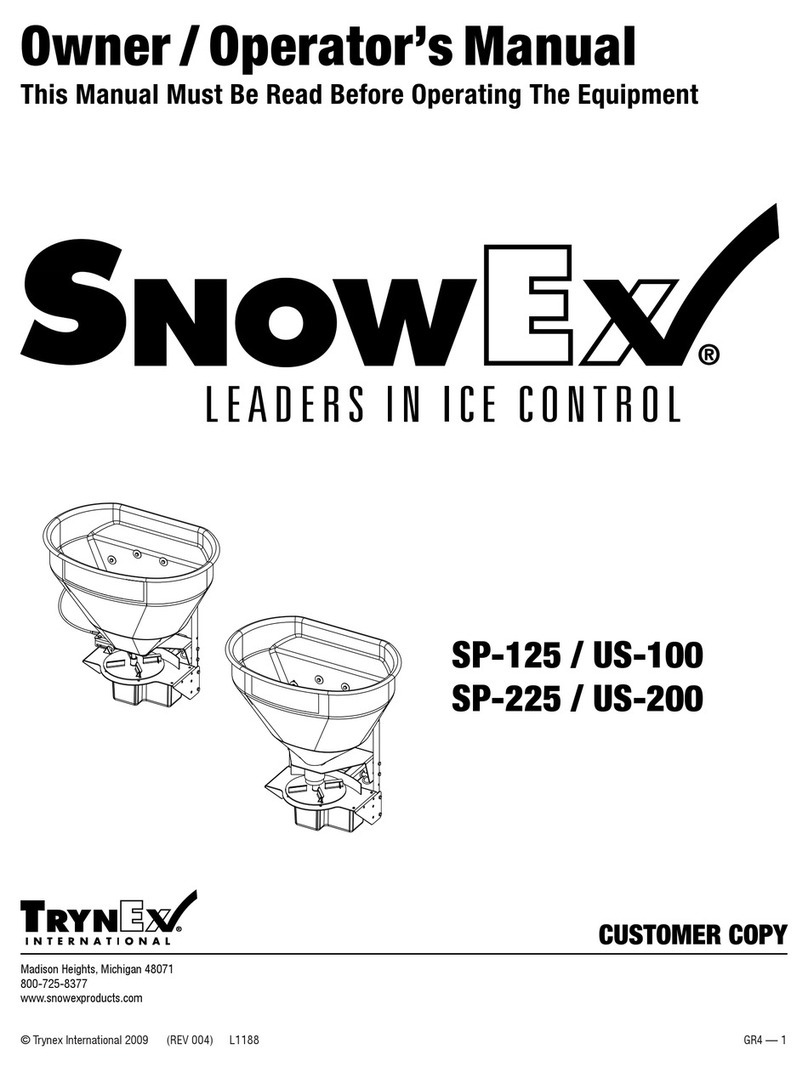
Trynex International
Trynex International SnowEx SP-125 Owner's manual
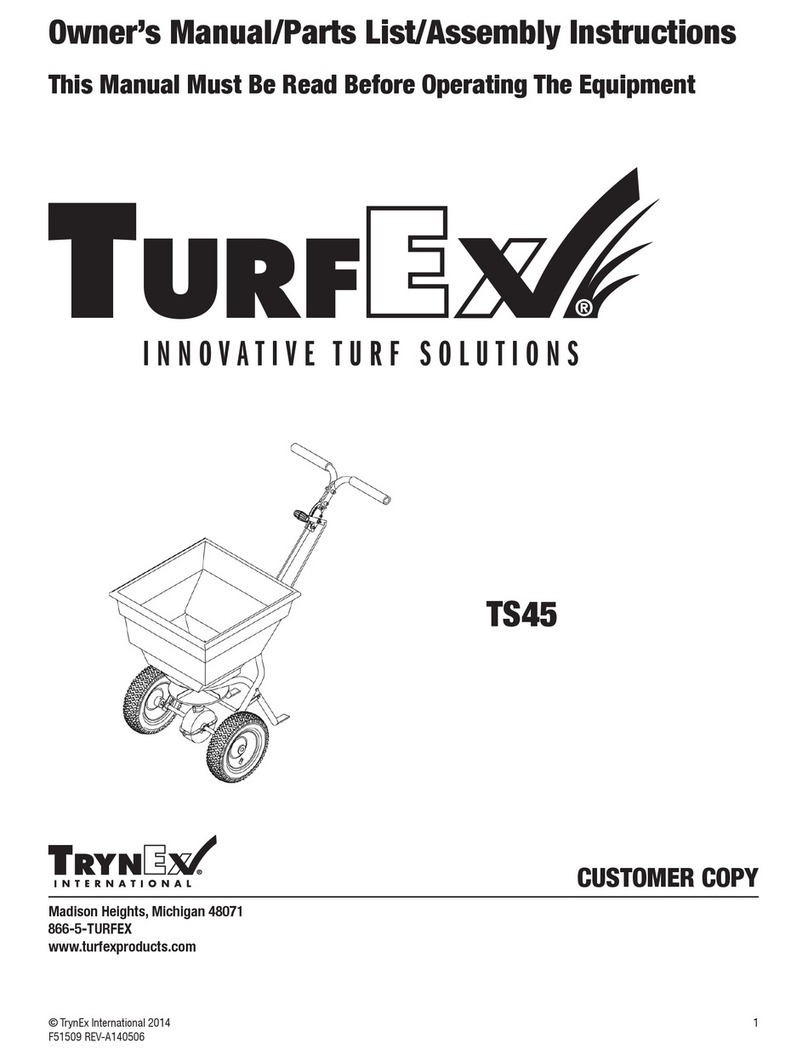
Trynex International
Trynex International TurfEx TS45 User manual

Trynex International
Trynex International SnowEx Pro 575X User manual
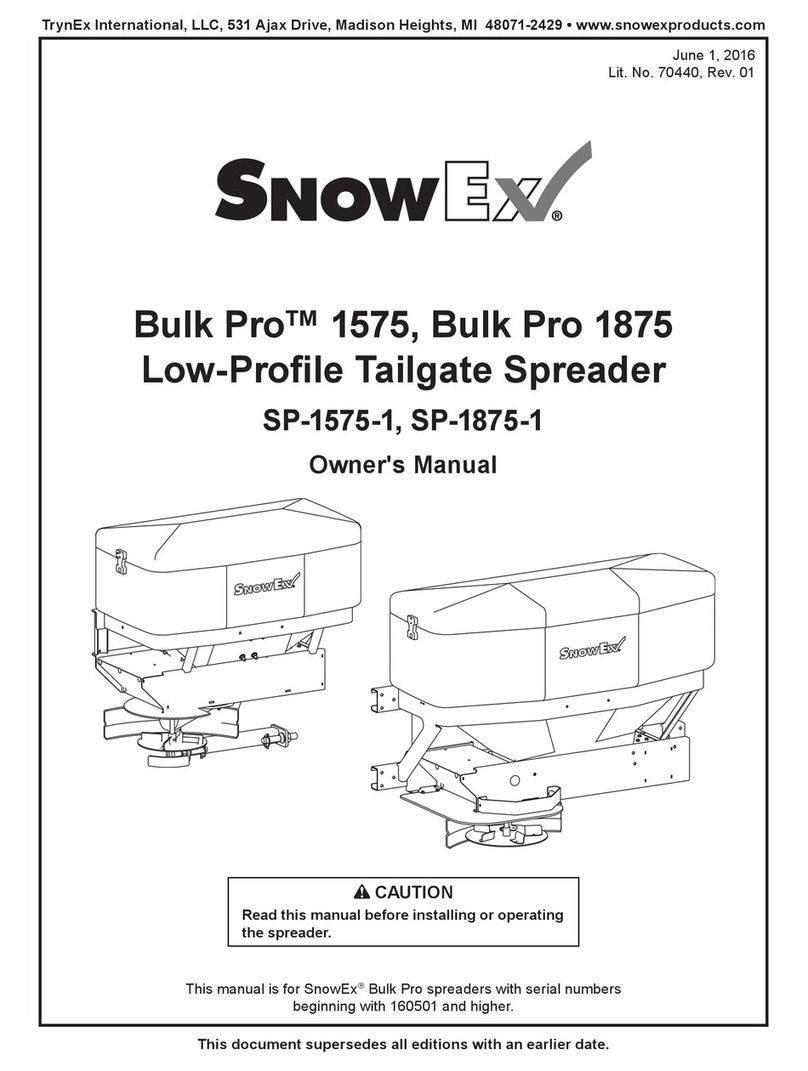
Trynex International
Trynex International SnowEx Bulk Pro 1875 User manual
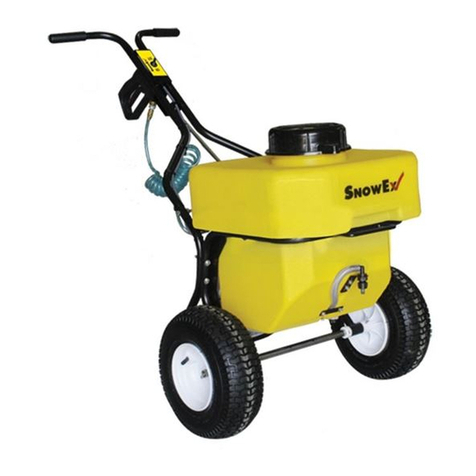
Trynex International
Trynex International SnowEx SL-80 Owner's manual

Trynex International
Trynex International SnowEx Precision Pro SP-1675 User manual

Trynex International
Trynex International SnowEx V-Maxx 8500 User manual
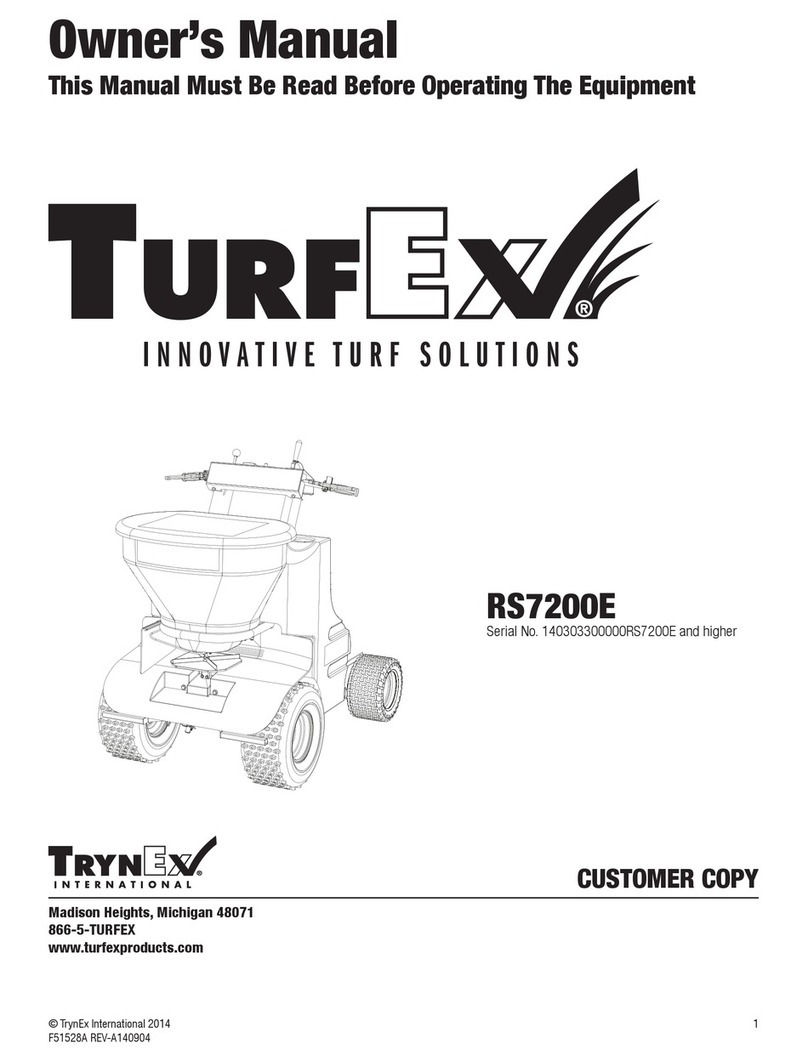
Trynex International
Trynex International TurfEx RS7200E User manual



